Determination of Gaseous and Particulate Secondary Amines in the Atmosphere Using Gas Chromatography Coupled with Electron Capture Detection
Abstract
:1. Introduction
2. Materials and Methods
2.1. Chemicals and Reagents
2.2. Derivatization and Extraction
2.3. GC-ECD Parameters
2.4. Method Validation
2.5. Field Sampling
2.6. Sample Pretreatment
2.7. Data Analysis
3. Results and Discussion
3.1. Optimization of the Analytical Procedure
3.2. Optimization of GC-ECD Parameters
3.3. Sampling and Extraction Efficiencies
3.4. Method Validation
3.5. Analysis of Real Samples
4. Conclusions
Author Contributions
Funding
Conflicts of Interest
References
- Kameda, T. Atmospheric Chemistry of Polycyclic Aromatic Hydrocarbons and Related Compounds. J. Health Sci. 2011, 57, 504–511. [Google Scholar] [CrossRef] [Green Version]
- Liu, P.; Song, M.; Zhao, T.; Gunthe, S.S.; Ham, S.; He, Y.; Qin, Y.M.; Gong, Z.; Amorim, J.C.; Bertram, A.K.; et al. Resolving the Mechanisms of Hygroscopic Growth and Cloud Condensation Nuclei Activity for Organic Particulate Matter. Nat. Commun. 2018, 9, 4076. [Google Scholar] [CrossRef] [PubMed] [Green Version]
- Müller, A.; Miyazaki, Y.; Tachibana, E.; Kawamura, K.; Hiura, T. Evidence of a Reduction in Cloud Condensation Nuclei Activity of Water-Soluble Aerosols Caused by Biogenic Emissions in a Coolerate Forest. Sci. Rep. 2017, 7, 1–9. [Google Scholar] [CrossRef] [PubMed]
- Duan, J.; Lyu, R.; Wang, Y.; Xie, X.; Wu, Y.; Tao, J.; Cheng, T.; Liu, Y.; Peng, Y.; Zhang, R.; et al. Particle Liquid Water Content and Aerosol Acidity Acting as Indicators of Aerosol Activation Changes in Cloud Condensation Nuclei (CCN) during Pollution Eruption in Guangzhou of South China. Aerosol Air Qual. Res. 2019, 19, 2662–2670. [Google Scholar] [CrossRef]
- Angeling, S.; Suess, D.T.; Prather, K.A. Formation of Aerosol Particles from Reactions of Secondary and Tertiary Alkylamines: Characterization by Aerosol Time-of-Flight Mass Spectrometry. Environ. Sci. Technol. 2001, 35, 3130–3138. [Google Scholar] [CrossRef]
- Murphy, S.M.; Sorooshian, A.; Kroll, J.H.; Ng, N.L.; Chhabra, P.; Tong, C.; Surratt, J.D.; Knipping, E. Secondary Aerosol Formation from Atmospheric Reactions of Aliphatic Amines. Atmos. Chem. Phys. 2007, 7, 2313–2337. [Google Scholar] [CrossRef] [Green Version]
- Wang, Y.; Xin, J.; Li, Z.; Wang, S.; Wang, P.; Hao, W.M.; Nordgren, B.L.; Chen, H.; Wang, L.; Sun, Y. Seasonal Variations in Aerosol Optical Properties over China. J. Geophys. Res. Atmos. 2011, 116, 1–14. [Google Scholar] [CrossRef]
- Smith, J.N.; Barsantia, K.C.; Friedlia, H.R.; Ehnd, M.; Kulmala, M.; Collins, D.R.; Scheckman, J.H.; Williams, B.J.; McMurry, P.H. Observations of Aminium Salts in Atmospheric Nanoparticles and Possible Climatic Implications. Proc. Natl. Acad. Sci. USA 2010, 107, 6634–6639. [Google Scholar] [CrossRef] [Green Version]
- Qiu, C.; Zhang, R. Multiphase Chemistry of Atmospheric Amines. Phys. Chem. Chem. Phys. 2013, 15, 5738–5752. [Google Scholar] [CrossRef]
- Chan, L.P.; Chan, C.K. Displacement of Ammonium from Aerosol Particles by Uptake of Triethylamine. Aerosol Sci. Technol. 2012, 46, 236–247. [Google Scholar] [CrossRef] [Green Version]
- Ge, X.; Wexler, A.S.; Clegg, S.L. Atmospheric Amines-Part I. A Review. Atmos. Environ. 2011, 45, 524–546. [Google Scholar] [CrossRef]
- Jen, C.N.; Bachman, R.; Zhao, J.; Mcmurry, P.H.; Hanson, D.R. Diamine-Sulfuric Acid Reactions Are a Potent Source of New Particle Formation. Geophys. Res. Lett. 2016, 43, 867–873. [Google Scholar] [CrossRef] [Green Version]
- Li, Z.; Zhou, R.; Wang, Y.; Wang, G.; Chen, M.; Li, Y.; Wang, Y.; Yi, Y.; Hou, Z.; Guo, Q.; et al. Characteristics and Sources of Amine-Containing Particles in the Urban Atmosphere of Liaocheng, a Seriously Polluted City in North China during the COVID-19 Outbreak. Environ. Pollut. 2021, 289, 117887. [Google Scholar] [CrossRef] [PubMed]
- Westerholm, R.; Li, H.; Almén, J. Estimation of Aliphatic Amine Emissions in Automobile Exhausts. Chemosphere 1993, 27, 1381–1384. [Google Scholar] [CrossRef]
- Cadle, S.H.; Mulawa, P.A. Low-Molecular-Weight Aliphatic Amines in Exhaust from Catalyst-Equipped Cars. Environ. Sci. Technol. 1980, 14, 718–723. [Google Scholar] [CrossRef]
- Ábalos, M.; Bayona, J.M.; Ventura, F. Development of a Solid-Phase Microextraction GC-NPD Procedure for the Determination of Free Volatile Amines in Wastewater and Sewage-Polluted Waters. Anal. Chem. 1999, 71, 3531–3537. [Google Scholar] [CrossRef]
- Schade, G.W.; Crutzen, P.J. Emission of Aliphatic Amines from Animal Husbandry and Their Reactions: Potential Source of N2O and HCN. J. Atmos. Chem. 1995, 22, 319–346. [Google Scholar] [CrossRef]
- Chang, Y.; Gao, Y.; Lu, Y.; Qiao, L.; Kuang, Y.; Cheng, K.; Wu, Y.; Lou, S.; Jing, S.; Wang, H.; et al. Discovery of a Potent Source of Gaseous Amines in Urban China. Environ. Sci. Technol. Lett. 2021, 8, 725–731. [Google Scholar] [CrossRef]
- Zhang, Q.; Anastasio, C. Free and Combined Amino Compounds in Atmospheric Fine Particles (PM2.5) and Fog Waters from Northern California. Atmos. Environ. 2003, 37, 2247–2258. [Google Scholar] [CrossRef]
- U.S. Department of Health and Human Services. Report on Carcinogens, 12th ed.; National Toxicology Program; U.S. Department of Health and Human Services, Public Health Service, National Institutes of Health: Research Triangle Park, NC, USA, 2011; pp. 1–498.
- Huang, Y.; Chen, H.; Wang, L.; Yang, X.; Chen, J. Single Particle Analysis of Amines in Ambient Aerosol in Shanghai. Environ. Chem. 2012, 9, 202–210. [Google Scholar] [CrossRef] [Green Version]
- Gunsch, M.J.; Liu, J.; Moffett, C.E.; Sheesley, R.J.; Wang, N.; Zhang, Q.; Watson, T.B.; Pratt, K.A. Diesel Soot and Amine-Containing Organic Sulfate Aerosols in an Arctic Oil Field. Environ. Sci. Technol. 2020, 54, 92–101. [Google Scholar] [CrossRef] [PubMed]
- You, Y.; Kanawade, V.P.; De Gouw, J.A.; Guenther, A.B.; Madronich, S.; Sierra-Hernández, M.R.; Lawler, M.; Smith, J.N.; Takahama, S.; Ruggeri, G.; et al. Atmospheric Amines and Ammonia Measured with a Chemical Ionization Mass Spectrometer (CIMS). Atmos. Chem. Phys. 2014, 14, 12181–12194. [Google Scholar] [CrossRef] [Green Version]
- Smith, J.; Stark, H.; Browne, E.; Hanson, D. HI-SCALE Nanoparticle Composition and Precursors Field Campaign Report; DOE/SC-ARM-17-023; Stafford, R., ARM Climate Research Facility, Eds.; DOE Office of Science Atmospheric Radiation Measurement (ARM) Program: Barrow, Alaska, 2017.
- Sorooshian, A.; Murphy, S.M.; Hersey, S.; Gates, H.; Padro, L.T.; Nenes, A.; Brechtel, F.J.; Jonsson, H.; Flagan, R.C.; Seinfeld, J.H. Comprehensive Airborne Characterization of Aerosol from a Major Bovine Source. Atmos. Chem. Phys. 2008, 8, 5489–5520. [Google Scholar] [CrossRef] [Green Version]
- Chen, T.; Ge, Y.; Liu, Y.; He, H. N-Nitration of Secondary Aliphatic Amines in the Particle Phase. Chemosphere 2022, 293, 133639. [Google Scholar] [CrossRef]
- Parshintsev, J.; Rönkkö, T.; Helin, A.; Hartonen, K.; Riekkola, M.L. Determination of Atmospheric Amines by On-Fiber Derivatization Solid-Phase Microextraction with 2,3,4,5,6-Pentafluorobenzyl Chloroformate and 9-Fluorenylmethoxycarbonyl Chloride. J. Chromatogr. A 2015, 1376, 46–52. [Google Scholar] [CrossRef]
- Choi, N.R.; Lee, J.Y.; Ahn, Y.G.; Kim, Y.P. Determination of Atmospheric Amines at Seoul, South Korea via Gas Chromatography/Tandem Mass Spectrometry. Chemosphere 2020, 258, 127367. [Google Scholar] [CrossRef]
- Liu, X.; Wang, H.; Liang, S.; Zhang, H. Determination of Primary and Secondary Aliphatic Amines by Reversed-Phase High-Performance Liquid Chromatography. Anal. Chim. Acta 2001, 441, 45–52. [Google Scholar] [CrossRef]
- Huang, X.; Deng, C.; Zhuang, G.; Lin, J.; Xiao, M. Quantitative Analysis of Aliphatic Amines in Urban Aerosols Based on Online Derivatization and High Performance Liquid Chromatography. Environ. Sci. Process. Impacts 2016, 18, 796–801. [Google Scholar] [CrossRef]
- Zhou, S.; Lin, J.; Qin, X.; Chen, Y.; Deng, C. Determination of Atmospheric Alkylamines by Ion Chromatography Using 18-Crown-6 as Mobile Phase Additive. J. Chromatogr. A 2018, 1563, 154–161. [Google Scholar] [CrossRef]
- Hermans, C.; Jonkers, A.C.A.; De Bokx, P.K. Determination of Amines in the Presence of Excess Ammonia by Ion Chromatography-Mass Spectrometry. J. Chromatogr. Sci. 2010, 48, 544–548. [Google Scholar] [CrossRef] [Green Version]
- Kataoka, H. Derivatization Reactions for the Determination of Amines by Gas Chromatography and Their Applications in Environmental Analysis. J. Chromatogr. A 1996, 733, 19–34. [Google Scholar] [CrossRef]
- de Zeeuw, J.; Luong, J. Developments in Stationary Phase Technology for Gas Chromatography. TrAC-Trends Anal. Chem. 2002, 21, 594–607. [Google Scholar] [CrossRef]
- de Zeeuw, J.; Stricek, R.; Stidsen, G. An Advanced Base-Deactivated Capillary Column for Analysis of Volatile Amines, Ammonia, and Alcohols. Am. Lab. 2011, 43, 37–40. [Google Scholar]
- Ferreira, A.M.C.; Laespada, M.E.F.; Pavón, J.L.P.; Cordero, B.M. In Situ Aqueous Derivatization as Sample Preparation Technique for Gas Chromatographic Determinations. J. Chromatogr. A 2013, 1296, 70–83. [Google Scholar] [CrossRef] [PubMed]
- Danielson, N.D.; Gallagher, P.A.; Bao, J.J. Chemical Reagents and Derivatization Procedures in Drug Analysis. Encycl. Anal. Chem. 2008, 7042–7076. [Google Scholar] [CrossRef]
- Płotka-Wasylka, J.M.; Morrison, C.; Biziuk, M.; Namieśnik, J. Chemical Derivatization Processes Applied to Amine Determination in Samples of Different Matrix Composition. Chem. Rev. 2015, 115, 4693–4718. [Google Scholar] [CrossRef] [Green Version]
- Poole, C.F. Derivatization Reactions for Use with the Electron-Capture Detector. J. Chromatogr. A 2013, 1296, 15–24. [Google Scholar] [CrossRef]
- Tao, X.; Liu, Y.; Wang, Y.; Qiu, Y.; Lin, J.; Zhao, A.; Su, M.; Jia, W. GC-MS with Ethyl Chloroformate Derivatization for Comprehensive Analysis of Metabolites in Serum and Its Application to Human Uremia. Anal. Bioanal. Chem. 2008, 391, 2881–2889. [Google Scholar] [CrossRef]
- Cheng, G.; Hu, Y.; Sun, M.; Chen, Y.; Chen, Y.; Zong, C.; Chen, J.; Ge, X. Characteristics and Potential Source Areas of Aliphatic Amines in PM2.5 in Yangzhou, China. Atmos. Pollut. Res. 2020, 11, 296–302. [Google Scholar] [CrossRef]
- Akyüz, M. Simultaneous Determination of Aliphatic and Aromatic Amines in Ambient Air and Airborne Particulate Matters by Gas Chromatography-Mass Spectrometry. Atmos. Environ. 2008, 42, 3809–3819. [Google Scholar] [CrossRef]
- Rittenbach, K.; Sloley, B.D.; Ling, L.; Coutts, R.T.; Shan, J.; Baker, G.B. A Rapid, Sensitive Electron-Capture Gas Chromatographic Procedure for Analysis of Metabolites of N-Methyl,N-Propargylphenylethylamine, a Potential Neuroprotective Agent. J. Pharmacol. Toxicol. Methods 2005, 52, 373–378. [Google Scholar] [CrossRef] [PubMed]
- Asghar, S.J.; Baker, G.B.; Rauw, G.A.; Silverstone, P.H. A Rapid Method of Determining Amphetamine in Plasma Samples Using Pentafluorobenzenesulfonyl Chloride and Electron-Capture Gas Chromatography. J. Pharmacol. Toxicol. Methods 2001, 46, 111–115. [Google Scholar] [CrossRef]
- Hornung, R.W.; Reed, L.D. Nondetectable Values Estimation of Average Concentration in the Presence of Nondetectable Values. Appl. Occup. Environ. Hyg. 1990, 5, 46–51. [Google Scholar] [CrossRef]
- Verriele, M.; Plaisance, H.; Depelchin, L.; Benchabane, S.; Locoge, N.; Meunier, G. Determination of 14 Amines in Air Samples Using Midget Impingers Sampling Followed by Analysis with Ion Chromatography in Tandem with Mass Spectrometry. J. Environ. Monit. 2012, 14, 402–408. [Google Scholar] [CrossRef]
- Yao, L.; Wang, M.Y.; Wang, X.K.; Liu, Y.J.; Chen, H.F.; Zheng, J.; Nie, W.; Ding, A.J.; Geng, F.H.; Wang, D.F.; et al. Detection of Atmospheric Gaseous Amines and Amides by a High-Resolution Time-of-Flight Chemical Ionization Mass Spectrometer with Protonated Ethanol Reagent Ions. Atmos. Chem. Phys. 2016, 16, 14527–14543. [Google Scholar] [CrossRef] [Green Version]
- Hellén, H.; Kieloaho, A.J.; Hakola, H. Gas-Phase Alkyl Amines in Urban Air; Comparison with a Boreal Forest Site and Importance for Local Atmospheric Chemistry. Atmos. Environ. 2014, 94, 192–197. [Google Scholar] [CrossRef]
- Vandenboer, T.C.; Petroff, A.; Markovic, M.Z.; Murphy, J.G. Size Distribution of Alkyl Amines in Continental Particulate Matter and Their Online Detection in the Gas and Particle Phase. Atmos. Chem. Phys. 2011, 11, 4319–4332. [Google Scholar] [CrossRef] [Green Version]
- VandenBoer, T.C.; Markovic, M.Z.; Petroff, A.; Czar, M.F.; Borduas, N.; Murphy, J.G. Ion Chromatographic Separation and Quantitation of Alkyl Methylamines and Ethylamines in Atmospheric Gas and Particulate Matter Using Preconcentration and Suppressed Conductivity Detection. J. Chromatogr. A 2012, 1252, 74–83. [Google Scholar] [CrossRef]
- Shen, W.; Ren, L.; Zhao, Y.; Zhou, L.; Dai, L.; Ge, X.; Kong, S.; Yan, Q.; Xu, H.; Jiang, Y.; et al. C1-C2 Alkyl Aminiums in Urban Aerosols: Insights from Ambient and Fuel Combustion Emission Measurements in the Yangtze River Delta Region of China. Environ. Pollut. 2017, 230, 12–21. [Google Scholar] [CrossRef]
- Majedi, S.M.; Lee, H.K. Combined Dispersive Solid-Phase Extraction-Dispersive Liquid–Liquid Microextraction-Derivatization for Gas Chromatography–Mass Spectrometric Determination of Aliphatic Amines on Atmospheric Fine Particles. J. Chromatogr. A 2017, 1486, 86–95. [Google Scholar] [CrossRef]
- Tzitzikalaki, E.; Kalivitis, N.; Kanakidou, M. Observations of Gas-Phase Alkylamines at a Coastal Site in the East Mediterranean Atmosphere. Atmosphere 2021, 12, 1454. [Google Scholar] [CrossRef]
- Ge, X.; Wexler, A.S.; Clegg, S.L. Atmospheric Amines e Part II. Thermodynamic Properties and Gas/Particle Partitioning Total: 187. Atmos. Environ. 2011, 45, 561–577. [Google Scholar] [CrossRef]
- Kulmala, M.; Kontkanen, J.; Junninen, H.; Lehtipalo, K.; Manninen, H.E.; Nieminen, T.; Petäjä, T.; Sipilä, M.; Schobesberger, S.; Rantala, P.; et al. Direct Observations of Atmospheric Aerosol Nucleation. Science 2013, 339, 943–946. [Google Scholar] [CrossRef] [PubMed]
- Yu, H.; McGraw, R.; Lee, S.H. Effects of Amines on Formation of Sub-3 Nm Particles and Their Subsequent Growth. Geophys. Res. Lett. 2012, 39, 3–7. [Google Scholar] [CrossRef] [Green Version]
- Zhang, R.; Khalizov, A.; Wang, L.; Hu, M.; Xu, W. Nucleation and Growth of Nanoparticles in the Atmosphere. Chem. Rev. 2012, 112, 1957–2011. [Google Scholar] [CrossRef] [PubMed]
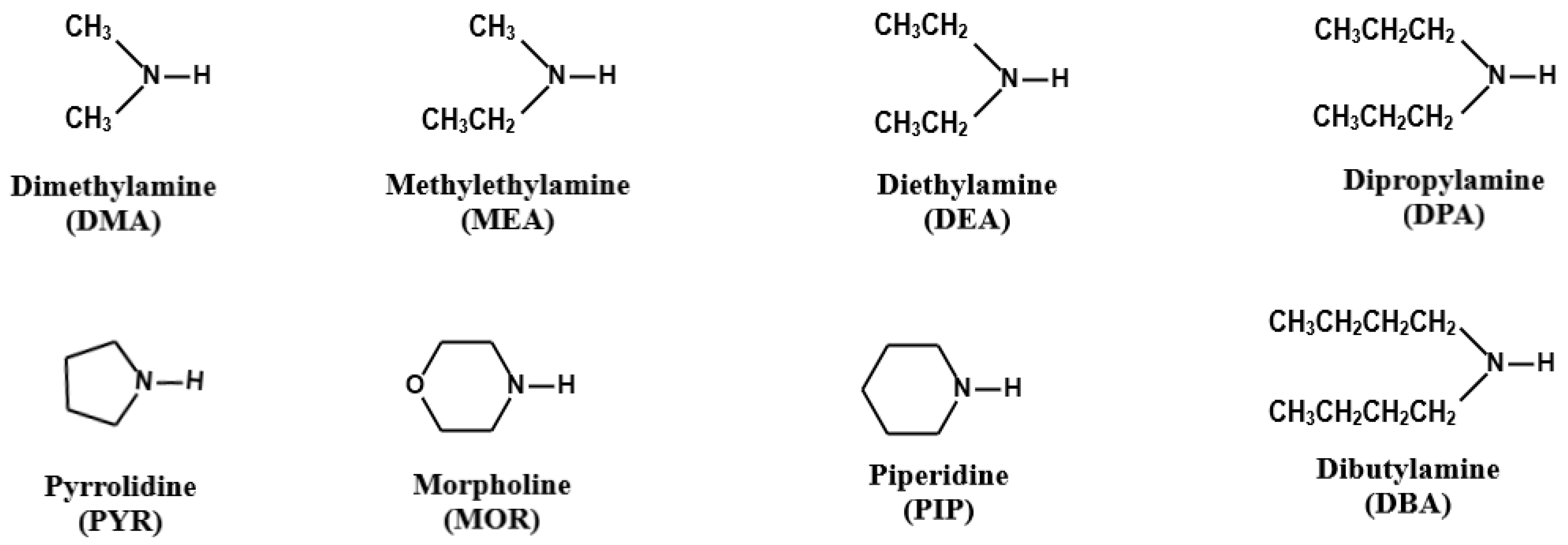


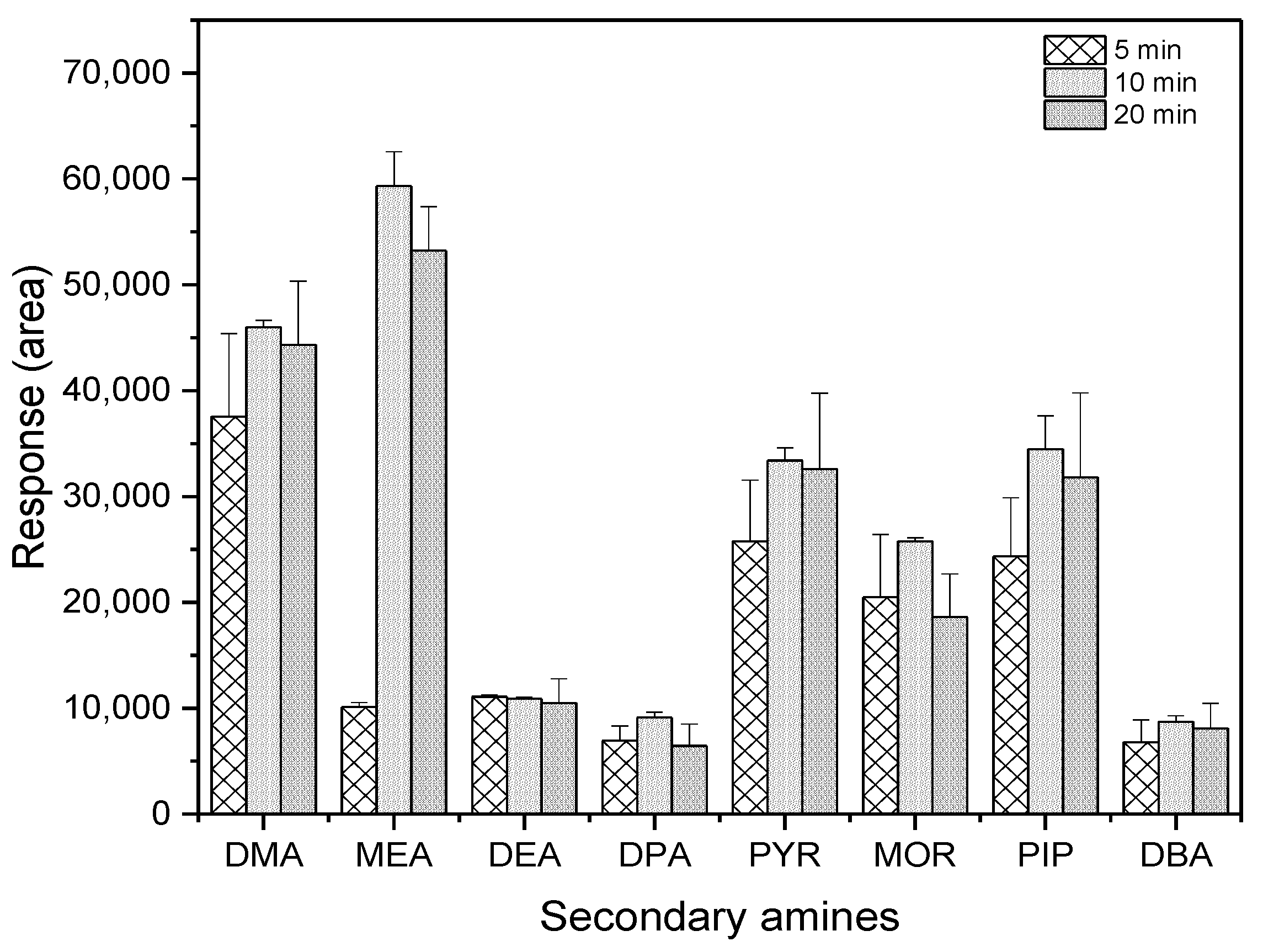

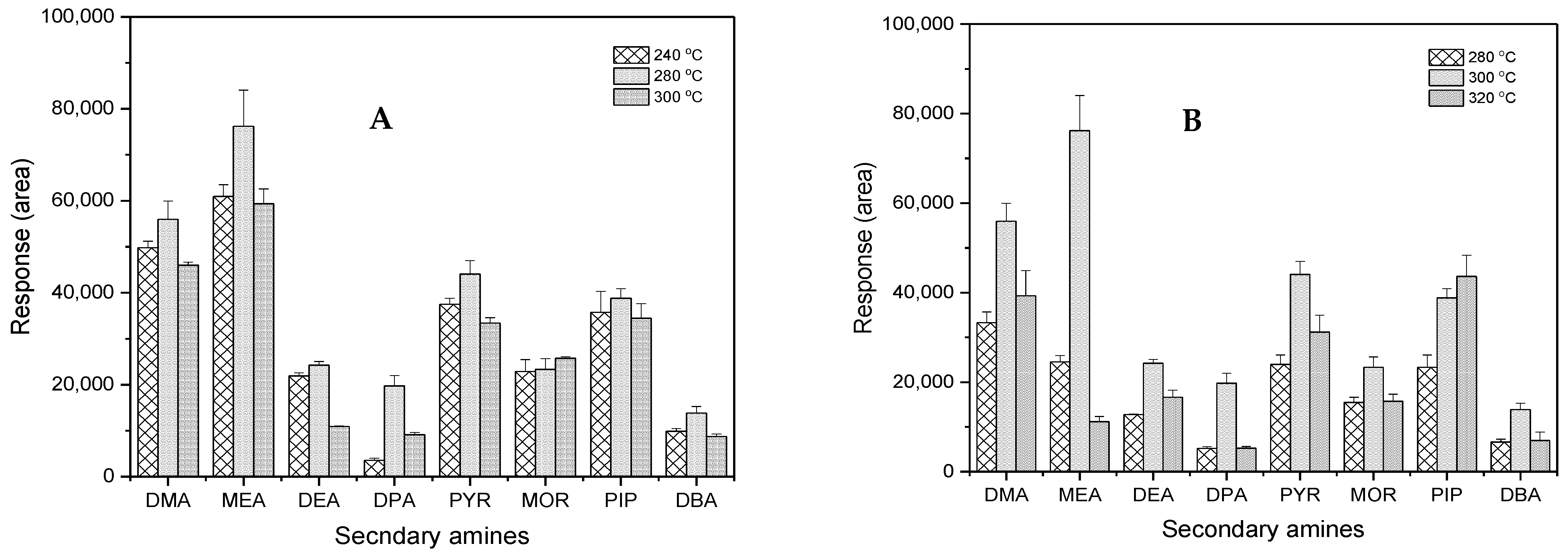
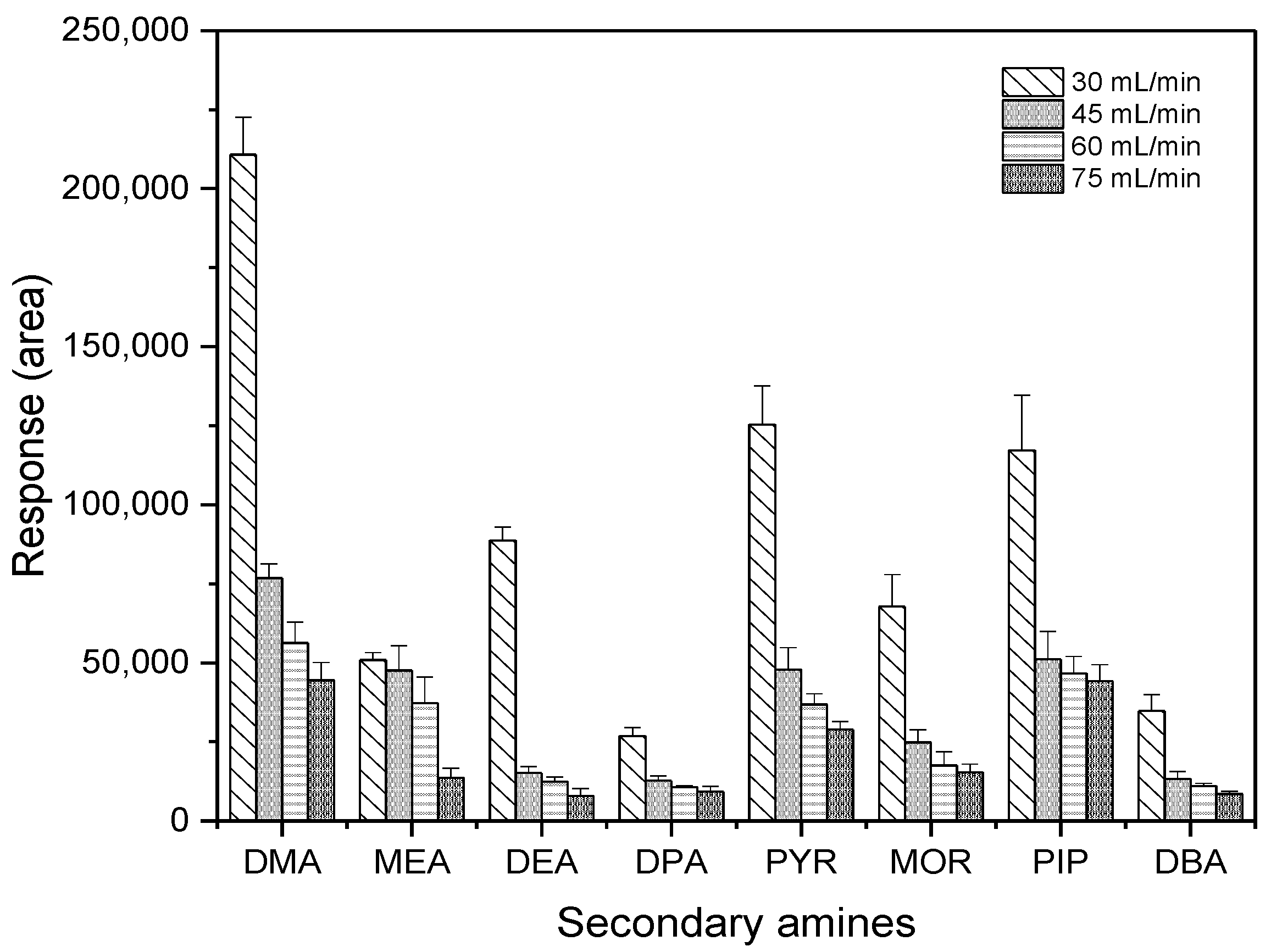
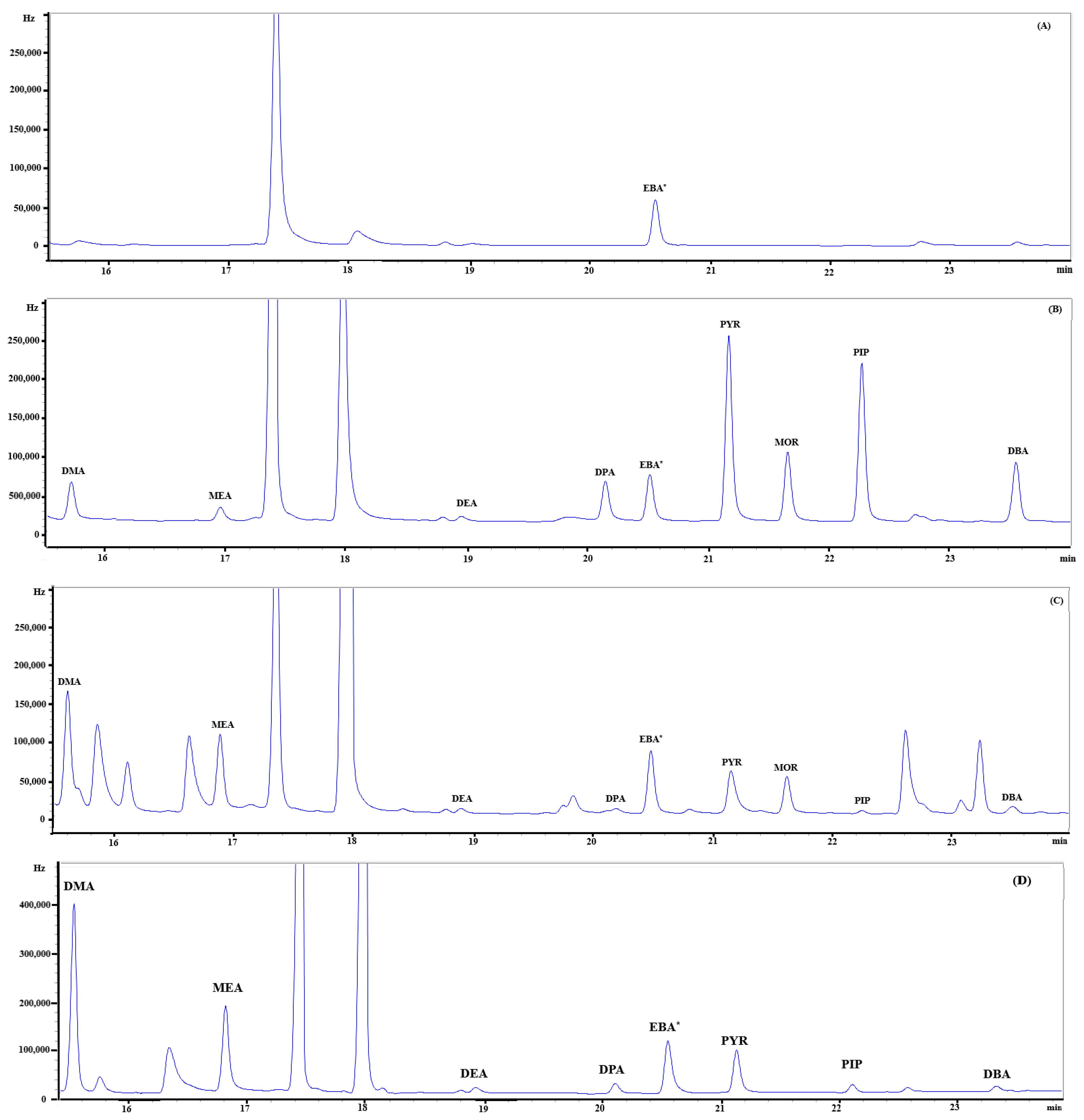
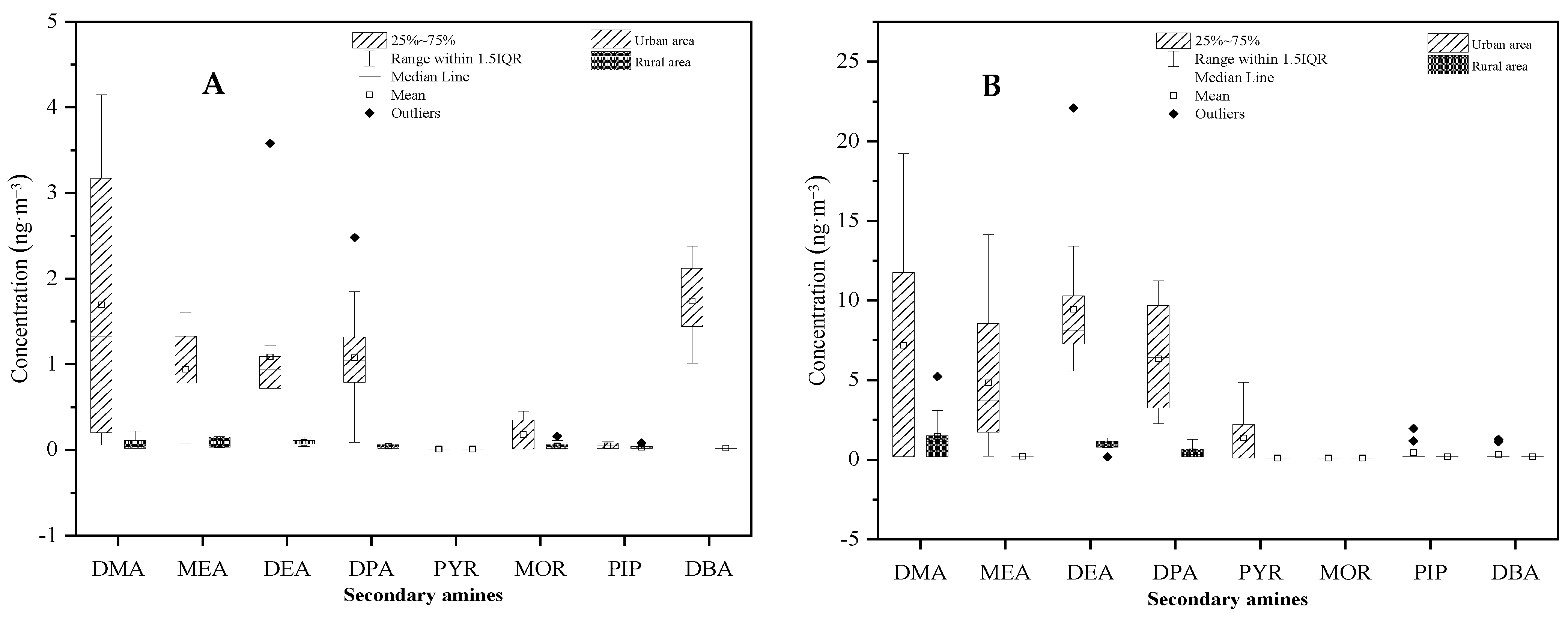
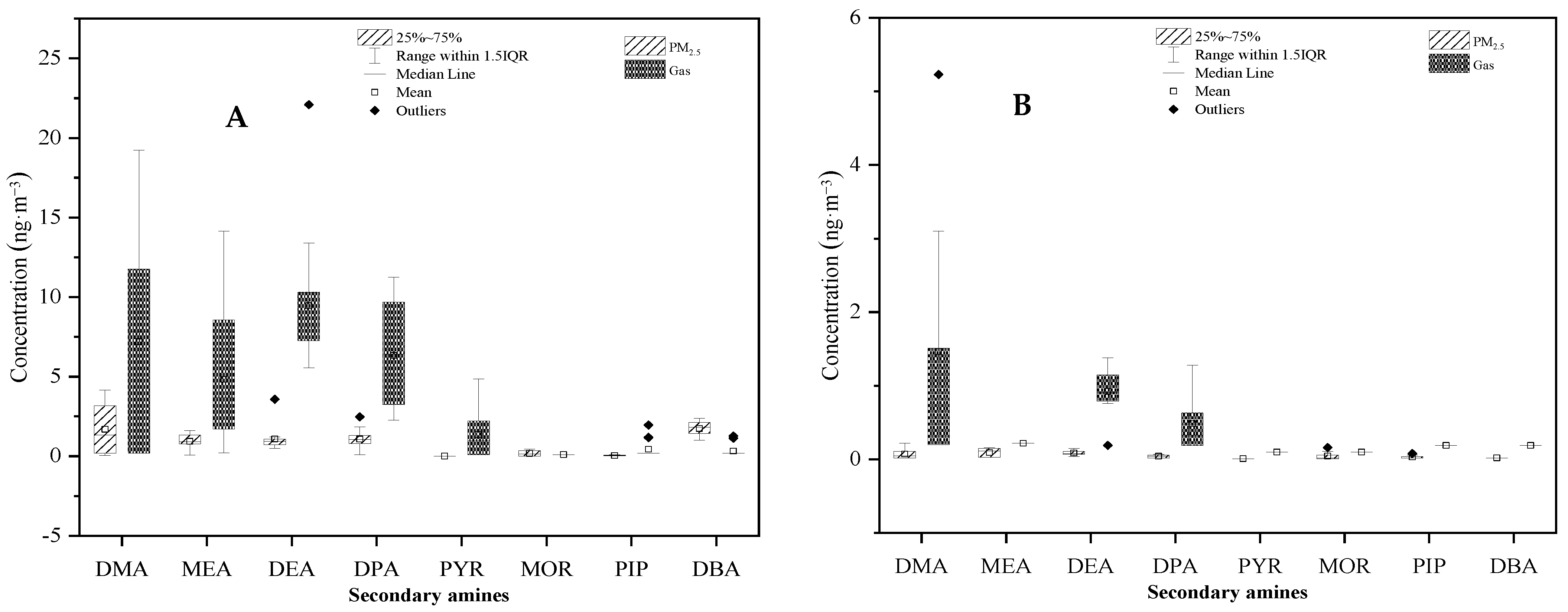
| Secondary Amines | Front Cartridge | Backup Cartridge | ||
|---|---|---|---|---|
| The First Extraction | The Second Extraction | The First Extraction | The Second Extraction | |
| DMA | 99.5 ± 0.7 | 0.06 ± 0.08 | 0.41 ± 0.58 | 0 |
| MEA | 97.5 ± 1.2 | 0.95 ± 0.25 | 0.81 ± 0.01 | 0.71 ± 1.00 |
| DEA | 99.2 ± 1.2 | 0.25 ± 0.35 | 0.49 ± 0.70 | 0.11± 0.15 |
| DPA | 98.3 ± 2.4 | 0.66 ± 0.94 | 1.06 ± 1.50 | 0 |
| PYR | 100 | 0 | 0 | 0 |
| MOR | 100 | 0 | 0 | 0 |
| PIP | 97.8 ± 2.7 | 1.51 ± 2.13 | 0.73± 0.61 | 0 |
| DBA | 82.2 ± 3.7 | 17.7± 3.69 | 0 | 0 |
| Secondary Amines | The First Extraction | The Second Extraction |
|---|---|---|
| DMA | 100 | 0 |
| MEA | 100 | 0 |
| DEA | 93.9 ± 2.5 | 6.10 ± 2.5 |
| DPA | 100 | 0 |
| PYR | 98.1 ± 2.2 | 1.94 ± 2.19 |
| MOR | 95.8 ± 7.3 | 4.23 ± 7.33 |
| PIP | 99.0 ± 1.8 | 1.05 ± 1.81 |
| DBA | 87.7 ± 3.9 | 12.3 ± 3.96 |
| Secondary Amines | PM2.5 | Gas | ||||
|---|---|---|---|---|---|---|
| Retention Time | r2 | MDL (ng·m−3) | LOQ (ng·m−3) | MDL (ng·m−3) | LOQ (ng·m−3) | |
| DMA | 15.621 | 0.9979 | 0.047 | 0.149 | 0.395 | 1.241 |
| MEA | 16.943 | 0.9947 | 0.053 | 0.166 | 0.442 | 1.389 |
| DEA | 18.942 | 0.9954 | 0.046 | 0.144 | 0.384 | 1.206 |
| DPA | 20.135 | 0.9933 | 0.045 | 0.140 | 0.372 | 1.167 |
| PYR | 21.158 | 0.9981 | 0.023 | 0.071 | 0.189 | 0.594 |
| MOR | 21.646 | 0.9929 | 0.024 | 0.077 | 0.204 | 0.641 |
| PIP | 22.262 | 0.9911 | 0.045 | 0.142 | 0.379 | 1.190 |
| DBA | 23.540 | 0.9923 | 0.056 | 0.144 | 0.383 | 1.203 |
| Phase | Site | Sampler | Extraction Method | Derivatization | Instrument | Method Validation | Reference |
|---|---|---|---|---|---|---|---|
| Gas | - | Glass impingers (distilled water) | - | No derivatization | IC-MS (mass spectrometry) | MDL: 50 ng·m−3 (DMA) 10 ng·m−3 (DEA) 3 ng·m−3 (DPA) Recovery:- | [46] |
| - | Glass impingers (distilled water) | - | No derivatization | IC-CD (conductivity cell) | MDL: 1200 ng·m−3 (DMA) 1050 ng·m−3 (DPA) Recovery:- | [46] | |
| Urban and rural, Chuncheon, South Korea | SPE cartridge (silica gel and sulfamic acid) | SPE (H2SO4 0.1 N) | PFBSC | GC-ECD | MDL:0.19~0.44 ng·m−3 Recovery: 91.2~117% | This study | |
| PM2.5 or PM10 | Urban Yangzhou, China | High volume air sampler | DLE (sonication, distilled water) | 9-fluorenylmethyl chloroformate (FMOC) | HPLC-FLD (fluorescence detection) | MDL:0.41–0.82 ng·m−3 (DMA) Recovery: 82.8~98.4% | [41] |
| Zonguldak, Turkey | Sequential air sampler | DLE (sonication, HCl 0.1 M) | Isobutyl chloroformate | GC-MS (mass spectrometry) | MDL: 0.015~0.0049 ng·m−3 Recovery: 88.0~97.2% | [42] | |
| Urban and rural, Chuncheon, South Korea | Cyclone sampler | DLE (sonication, H2SO4 0.1 N) | PFBSC | GC-ECD | MDL:0.02~0.05 ng·m−3 Recovery: 81.2~106% | This study |
| Secondary Amines | PM2.5 | Gas | ||||||
|---|---|---|---|---|---|---|---|---|
| Percent Recovery * | RSD (%) (n = 7) | Percent Recovery * | RSD (%) (n = 7) | |||||
| 30 pg (n = 3) | 120 pg (n = 3) | 210 pg (n = 3) | 30 pg (n = 3) | 120 pg (n = 3) | 210 pg (n = 3) | |||
| DMA | 83.2 ± 2.0 | 82.5 ± 4.6 | 84.4 ± 3.1 | 2.8 | 112 ± 2 | 99.6 ± 4.5 | 80.4 ± 2.3 | 2.0 |
| MEA | 81.2 ± 2.1 | 82.2 ± 0.2 | 81.5 ± 2.9 | 4.3 | 94.3 ± 3.6 | 93.1 ± 3.7 | 82.1 ± 2.7 | 3.1 |
| DEA | 89.2 ± 3.0 | 110 ± 2 | 106 ± 3 | 2.7 | 95.0 ± 3.7 | 106 ± 4 | 116 ± 4 | 6.9 |
| DPA | 86.7 ± 1.5 | 114 ± 3 | 101 ± 3 | 5.0 | 117 ± 4 | 103 ± 4 | 94.1 ± 3.3 | 6.0 |
| PYR | 94.9 ± 3.2 | 94.2 ± 3.4 | 95.8 ± 1 | 3.8 | 91.2 ± 1.0 | 97.5 ± 4.8 | 82.9 ± 2.7 | 2.2 |
| MOR | 103 ± 4.0 | 104 ± 4 | 109 ± 4 | 2.4 | 105 ± 4 | 96.8 ± 3.6 | 100 ± 5 | 6.8 |
| PIP | 101 ± 4.2 | 113 ± 1 | 108 ± 5 | 2.1 | 95.3 ± 3.0 | 105 ± 1 | 112 ± 3 | 8.3 |
| DBA | 106 ± 3.6 | 101 ± 4 | 92.6 ± 2.8 | 0.7 | 104 ± 4 | 102 ± 2 | 93.1 ± 4.5 | 5.5 |
| Secondary Amines | Urban Area (15) | Rural Area (10) | ||
|---|---|---|---|---|
| Gas | PM2.5 | Gas | PM2.5 | |
| DMA | 93.3 | 100 | 100 | 70 |
| MEA | 93.3 | 100 | _ | 60.0 |
| DEA | 100 | 100 | 90.0 | 100 |
| DPA | 100 | 100 | 50.0 | 70.0 |
| PYR | 60.0 | 26.7 | _ | _ |
| MOR | _ | 60.0 | _ | 60.0 |
| PIP | 20.0 | 53.3 | _ | _ |
| DBA | 13.3 | 100 | _ | _ |
| Compound | Urban Area (15) | Rural Area (10) | ||
|---|---|---|---|---|
| Gas | PM2.5 | Gas | PM2.5 | |
| DMA | 7.19 ± 6.59 <MDL–19.2 | 1.69 ± 1.54 0.06–4.15 | 1.47 ± 1.59 0.49–5.23 | 0.07 ± 0.06 <MDL–0.12 |
| MEA | 4.83 ± 3.95 <MDL–9.93 | 0.94 ± 0.45 0.08–1.61 | <MDL | 0.09 ± 0.06 <MDL–0.16 |
| DEA | 9.46 ± 4.04 5.56–22.1 | 1.08 ± 0.72 0.49–3.58 | 0.92 ± 0.33 <MDL–1.38 | 0.08 ± 0.04 0.04–0.15 |
| DPA | 6.33 ± 3.12 2.27–11.24 | 1.08 ± 0.58 0.09–2.48 | 0.49 ± 0.39 <MDL–1.28 | 0.04 ± 0.02 <MDL–0.07 |
| PYR | 1.37 ± 1.46 <MDL–4.85 | 0.14 ± 0.17 <MDL–0.4 | <MDL | <MDL |
| MOR | <MDL | 0.18 ± 0.17 <MDL–0.45 | <MDL | 0.05 ± 0.05 <MDL–0.16 |
| PIP | 0.44 ± 0.54 <MDL–1.96 | 0.05 ± 0.03 <MDL–0.10 | <MDL | <MDL |
| DBA | 0.32 ± 0.36 <MDL–1.27 | 1.74 ± 0.51 1.01–2.38 | <MDL | <MDL |
| Phase | Sampling Site | Number of Samples | Concentration | Reference |
|---|---|---|---|---|
| Gas | Urban area in Shanghai, China (July–August 2015) | - | 73.6 ± 26.3 ng·m−3 (DMA) 46.0 ± 23.6 ng·m−3 (DEA) | [47] |
| Urban in Helsinki, Finland (May–August 2011) | - | 43.4 ng·m−3 (DMA) 0.90 ng·m−3 (DEA) | [48] | |
| Downtown Toronto, Canada (June–July 2009) | 8 | <4.97 ng·m−3 (DMA) | [49] | |
| Chuncheon, Korea (urban) (June–September 2021) | 15 | 7.19 ± 6.6 ng·m−3 (DMA) 9.46 ± 4.04 ng·m−3 (DEA) | This study | |
| Egbert, ON, Canada (rural area) (October–November 2010) | - | 11.9 ± 3.9 ng·m−3 (DMA) | [50] | |
| Chuncheon, Korea (rural) (June–September 2021) | 10 | 1.47 ± 1.59 ng·m−3 (DMA) 0.92 ± 0.33 ng·m−3 (DEA) | This study | |
| PM2.5 | Urban in Yangzhou, China (April–November 2016) | 128 | 3.62 ± 3.9 ng·m−3 (DMA) | [41] |
| Urban in Yangtze River Delta region, China (November 2015–May 2016) | 103 | 4.3 ± 2.4 ng·m−3 (DMA) | [51] | |
| Urban in Singapore (September 2014) | - | 4.16 ng·m−3 (DMA) 1.52 ng·m−3 (DEA) | [52] | |
| Metropolitan Area, Seoul, Korea (January–December 2018) | 117 | 2.72 ± 1.49 ng·m−3 (DMA) 1.31 ± 0.49 ng·m−3 (DEA) | [28] | |
| Chuncheon, Korea (urban) (June–July 2009) | 15 | 1.69 ± 1.54 ng·m−3 (DMA) 1.08 ± 0.72 ng·m−3 (DEA) | This study | |
| Chuncheon, Korea (rural) (June–July 2009) | 10 | 0.07 ± 0.06 ng·m−3 (DMA) 0.08 ± 0.04 ng·m−3 (DEA) | This study |
Publisher’s Note: MDPI stays neutral with regard to jurisdictional claims in published maps and institutional affiliations. |
© 2022 by the authors. Licensee MDPI, Basel, Switzerland. This article is an open access article distributed under the terms and conditions of the Creative Commons Attribution (CC BY) license (https://creativecommons.org/licenses/by/4.0/).
Share and Cite
Mai, T.T.H.; Kim, H. Determination of Gaseous and Particulate Secondary Amines in the Atmosphere Using Gas Chromatography Coupled with Electron Capture Detection. Atmosphere 2022, 13, 664. https://doi.org/10.3390/atmos13050664
Mai TTH, Kim H. Determination of Gaseous and Particulate Secondary Amines in the Atmosphere Using Gas Chromatography Coupled with Electron Capture Detection. Atmosphere. 2022; 13(5):664. https://doi.org/10.3390/atmos13050664
Chicago/Turabian StyleMai, Thu Thi Hoai, and Hekap Kim. 2022. "Determination of Gaseous and Particulate Secondary Amines in the Atmosphere Using Gas Chromatography Coupled with Electron Capture Detection" Atmosphere 13, no. 5: 664. https://doi.org/10.3390/atmos13050664





